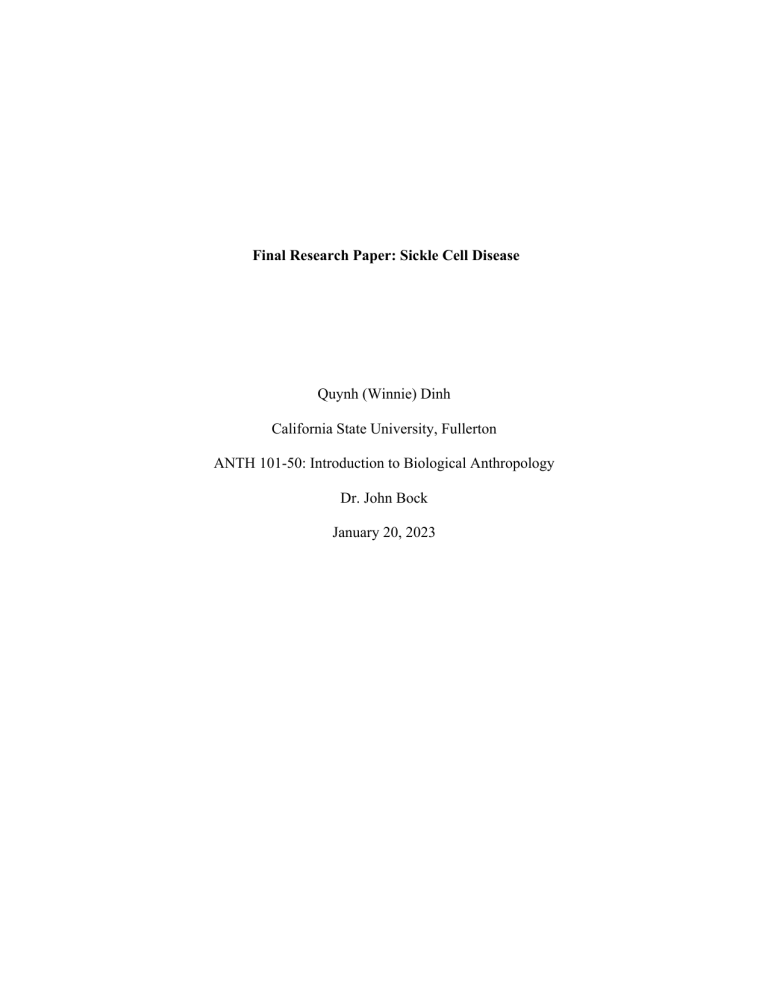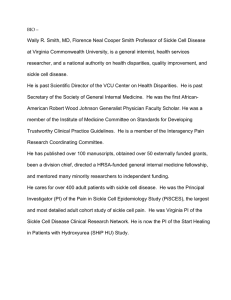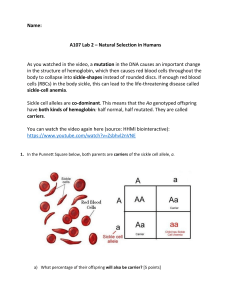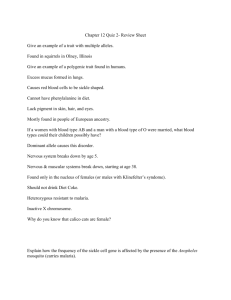
Final Research Paper: Sickle Cell Disease Quynh (Winnie) Dinh California State University, Fullerton ANTH 101-50: Introduction to Biological Anthropology Dr. John Bock January 20, 2023 Human beings vary in different ways all over the world, which may include height, weight, hair color, eye color, and so on. But regardless of the difference in appearance look, we all are humans, and our bodies need blood to continue the lives. However, not everyone is fortunate to be born with a healthy body and live a long life. During pregnancy, many babies get passed down abnormal genes from their parent, which cause abnormal health condition when they are in fetus. One of the abnormal condition will be mentioned in this research paper is sickle cell disease. Sickle cell disease is a group of inherited red blood cell disorders, which affects blood flow to organs and deprives the affected organs of blood and oxygen. Normally, red blood cells are disc-shaped and flexible enough to move easily through the blood vessels. In contrast, if a person has sickle cell disease, their red blood cells are shaped like a crescent or the blade of a sickle. When these blood cells with abnormal hemoglobin go through the smallest blood vessels, some of the cells form into rigid strands, become sticky, and then get stuck by clogging the capillaries. As a result, different parts of the body do not get enough oxygen they need. According to National Heart, Lung, and Blood Institute (2022), people with sickle cell disease are born with it. It’s passed down through a parent’s genes when a child has two sickle cell genes, one from each parent (Stanford Medicine Children’s Health, n.d.). However, they do not have the symptoms until they are about 5 or 6 months old. Symptoms may vary from person to person and can change over time. Some people have symptoms once a while; others suffer the pain very often. Early symptoms that might be observed in newborns having sickle cell may include: • Yellowing of the skin and whites of the eyes • Fatigue or fussiness from anemia • Painful swelling of the hands and feet Out of the symptoms mentioned above, the blocked blood flow can cause various health problems, such as severe pain episodes, stroke, and organ damage (2016). Having a family history of sickle disease also increases a child’s risk for the disease. In a statistic in the “Sickle Anemia” lecture video posted on class Canvas, it is mentioned that the S allele is most common among populations in tropical regions of Africa, the Mediterranean Sea, the Middle East and Southern India. Sickle cell disease is a lifelong illness. Back in the old days when it was the absence of modern medical treatment, most people with sickle cell disorder die before they reach adulthood. These days, however, with development of medical treatment, people with sickle cell disease can live long lives with proper management of the disease, including support from their family and strict adherence of medications and checkups with doctors. Until present, a bone marrow transplant is the only FDA-approved treatment for sickle cell disease patients. But it is not always the case for everyone to receive this cure. Many patients are too old for a transplant since it is risky for this group to do the surgery. On the other hand, many patients are not able to find a donor who is a good genetic match since they need a well-matched transplant to their body so that the patient can feel well as it is their old transplant. Parents who have children having sickle cell disease should follow their health conditions regularly at home, combined with management from specialists to prevent worst situation. They may not be able to fully prevent their child from having complications of sickle cell disease, but they can help their child be well by having a healthy lifestyle. Some of the healthy lifestyles they can adopt are exercise regularly, choose heart-healthy foods, drink enough water to avoid dehydration. Parents may want to keep their child stay away bad conditions that might trigger the crisis, such as cold weather, high altitudes, or swim in cold water, etc. Regions that have been found as having high populations of sickle cell disease are also those at high malaria risk. One of the deadliest form of malaria, falciparum malaria, is also prevalent in these regions. Malaria is a diseased caused by a parasite called Plasmodium. These parasites live inside Anopheles mosquitos. When an infected mosquito bites a person, parasites are transferred to them, multiply, and make them sick. Also, infected mosquitos pass parasites to many humans because the mosquitos do not get sick from the parasites. This explains why malaria spreads in community very easily. However, for sickle cell disease patients, sickle cell trait protects them against malaria. According to Sickle Cell Anemia (Canvas) lecture video, human behavior is also hypothesized to have influenced the evolution of the sickle cell allele. With the intensification of agricultural practices, humans cleared large areas of land, leaving open areas for rainwater to collect and stagnate. Therefore, it provides ideal breeding grounds for mosquito larvae growing close by human settlements. Moreover, with high demand on the food supply worldwide, governments are now implementing large-scale agricultural projects to meet this increased need. Hence, they need to contribute to further agricultural land expansion, which has in turn been linked to malaria risk. As malaria infections increased, the S allele was maintained by natural selection and passed on for future generations (Silk, 2021). In conclusion, sickle cell brings many health problems to patients, either kids or adults. With development of modern medical, patients can reduce severe pain by following strict cure from specialists and adopting a healthy lifestyle to live with this disease. Besides, in order to avoid the chance of passing abnormal genes to future generations, humans should consider stopping agricultural practices that increase the risk of causing harmful disease to our offspring. Work Cited Canvas. Sickle Anemia. Lecture Video. Retrieved January 20, 2023, from https://csufullerton.instructure.com/courses/3351907/quizzes/8378319?module_item_id=7 8435684 Default - Stanford Medicine Children's health. Stanford Medicine Children's Health - Lucile Packard Children's Hospital Stanford. (n.d.). Retrieved January 20, 2023, from https://www.stanfordchildrens.org/en/topic/default?id=sickle-cell-disease-in-children-90P02327 Longevity for those with sickle cell disease linked to care maintenance, family involvement. Longevity for those with Sickle Cell Disease Linked to Care Maintenance, Family Involvement - Hematology.org. (2016, October 4). Retrieved January 20, 2023, from https://www.hematology.org/newsroom/press-releases/2016/rare-patients-with-sickle-celldisease-live-nearly-twice-as-long-as-average Silk, J. B. (2021). 14. In How humans evolved (p. 369). essay, W.W. Norton & Company. Team, E. (2021, August). Malaria risk & sickle cell. Sickle. Retrieved January 20, 2023, from https://sickle-cell.com/clinical/malaria U.S. Department of Health and Human Services. (2022, July). Sickle cell disease. National Heart Lung and Blood Institute. Retrieved January 20, 2023, from https://www.nhlbi.nih.gov/resources/sickle-cell-disease







